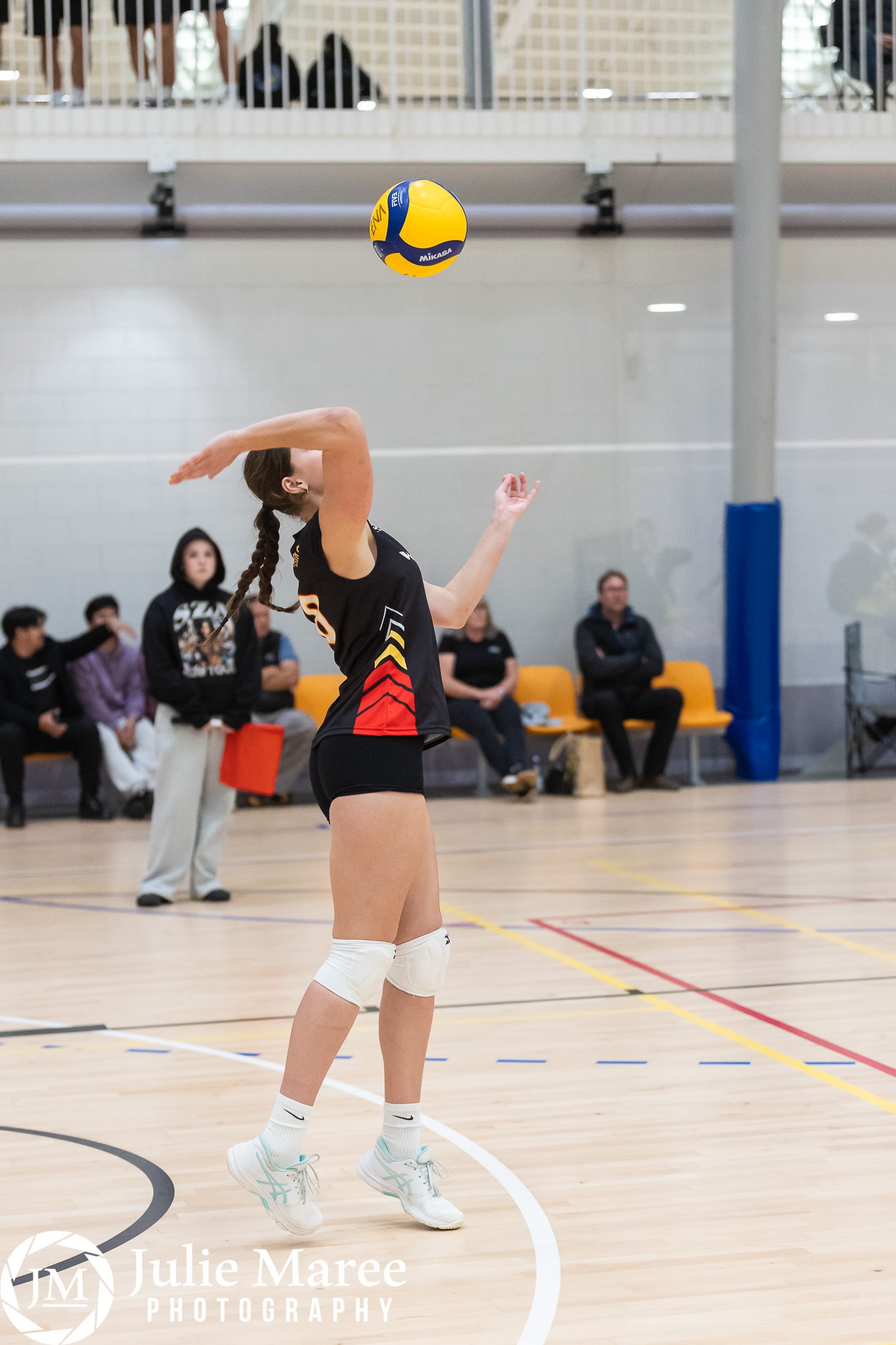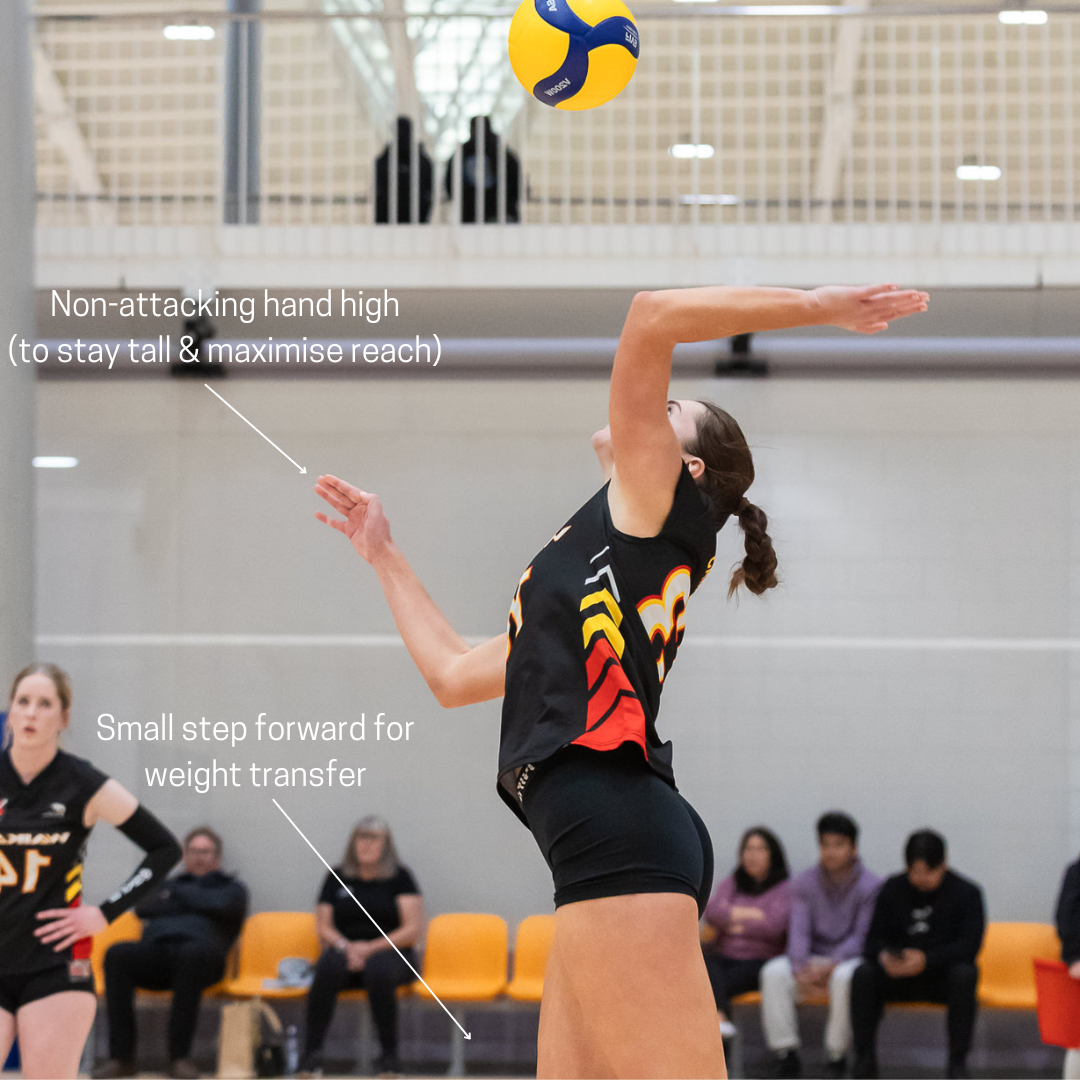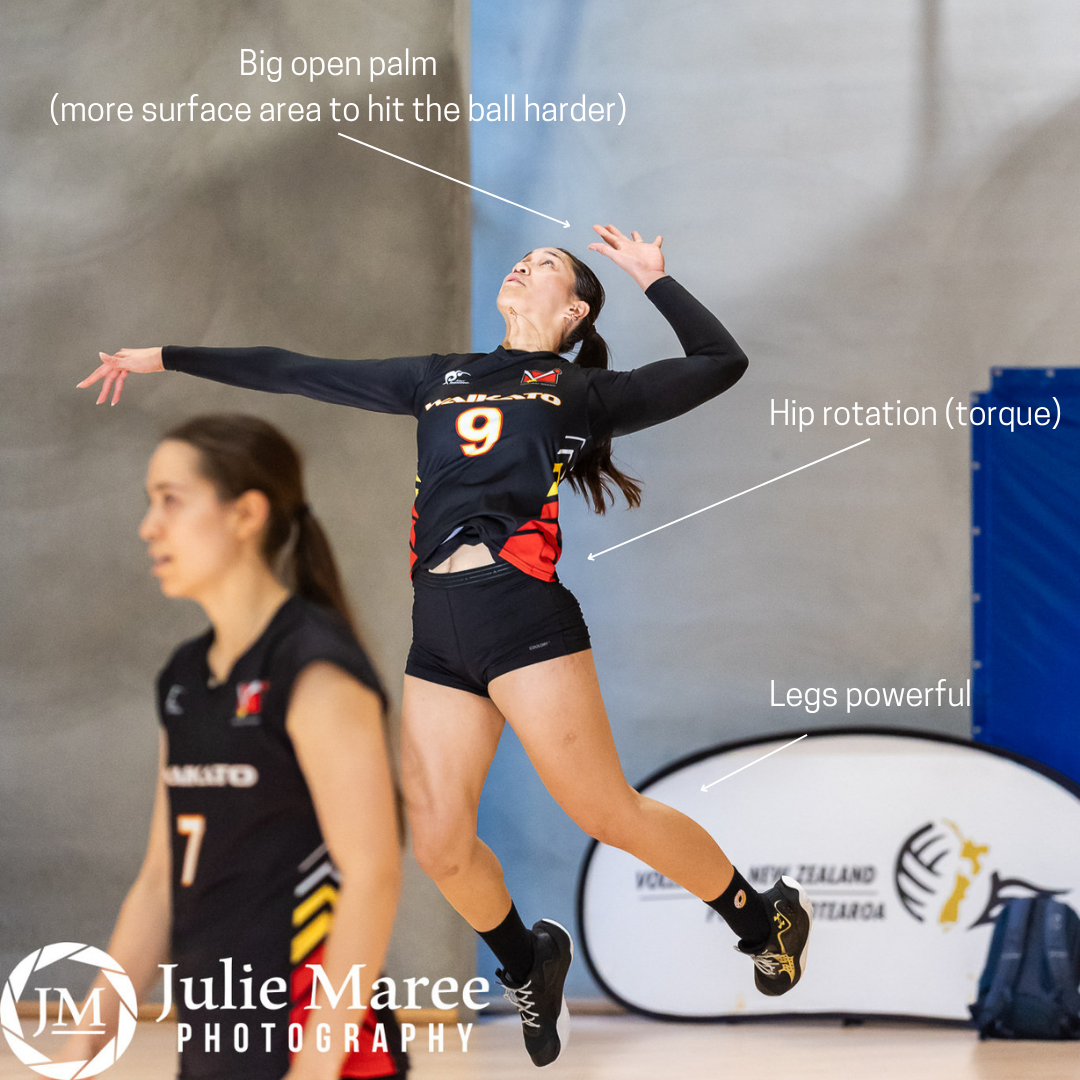
SERVING is considered a closed skill in volleyball, as it is the only skill where players have complete control over both the timing and execution without any external factors. The main objective of serving is to stress the opponent’s serve receive and to force them to make a bad pass, which lowers their chances of scoring a point.
Standing Float Serve
A ‘float’ serve refers to the way the ball travels over the net with minimal to no spin. The ball creates unpredictable movements with a floating (‘dancing’) effect that can change directions and trajectory, making it harder for passers to receive.
-
Start by standing tall with your back straight. Your shoulders relaxed but not slouched.
Position your body so that you are facing perpendicular to the net, meaning one shoulder points toward the net while the other points away from it.
Hold the ball in non-hitting hand (if doing a one handed toss) with a slightly bent elbow or hold ball in both hands (if doing a two handed toss).
Left foot forward (right handed) or right foot forward (left handed) and other foot slightly back. Ensure you are well balanced and planted on the ground.
Keep your hitting elbow pulled back, and ensure your hitting hand and wrist are strong, open, and flat. This position maximises the surface area for contacting the ball, allowing you to contact it effectively and create the floating effect.
-
The quality of your toss is crucial, as it directly impacts how you hit the ball and ultimately determines the effectiveness of your serve.
Toss the ball until reaches a consistent height suitable for your serve.
You can toss with one hand or both hands. If tossing with one hand, toss with your non-attacking hand.
If tossing with both hands, you have to go from toss to bow and arrow.
The toss should be slightly forward up in the air with no spin and slightly ahead of your hitting shoulder.
-
After the toss, get yourself into a bow and arrow action.
Keep non-hitting hand high to avoid lowering your contact point (you want to hit the serve with a tall posture).
-
Hit the ball with a throwing action.
Take a small step forward to help transfer your weight which allows you to hit the ball with more power.
Contact the ball on the palm of your hand in front of your body.
Rotate shoulder and hips to generate power (torque).
Face where you want the ball to go to.
Contact the ball high with extended elbow (remember to keep non-hitting hand high to avoid lowering your contact).
Jump Float Serve
A jump is added into the routine so we can contact the ball at a higher point which increases the downward trajectory of the serve. This adds more velocity and therefore increasing the level of difficulty for the opposing team to pass.
-
Stand tall (posture) facing perpendicular to the net.
Hold ball in non-hitting hand (if one handed toss) with a slightly bent elbow or hold ball in both hands (if two handed toss).
We want to start further from the service line as we need to make an approach.
-
The quality of the toss is incredibly important as it determines how you hit the ball, which in turns determines the quality of the serve.
Toss with 1 hand (non-attacking hand) or both hands.
Ball should be tossed towards the court (ball should land on or slightly in front of the serving line).
-
The approach is subjective so choose which you’re most comfortable with. The serving space can determine how you approach.
Four Steps:
Right Handed
Right, Left -Toss, Right, Left -Jump & Attack.
Left Handed
Left, Right -Toss, Left, Right -Jump & Attack.
Three Steps:
Right Handed
Left-Toss, Right, Left-Jump & Attack.
Left Handed
Right-Toss, Left, Right-Jump & Attack.
Two Steps:
Right Handed
Toss, Right, Left-Jump & Attack.
Left Handed
Toss, Left, Right-Jump & Attack.
-
Your arms go from toss straight to Bow & Arrow. Don't swing your arms back after you toss the ball as you need to get into the hitting action quickly.
Jump forward to meet the ball but keep ball in front of you.
Hit the ball with a throwing action. Pull your hitting arm back, keeping your elbow high. Swing forward, fully extending your arm at the moment of contact.
Open your shoulders and hip to generate more power (torque - rotation on a central axis).
Elbows come forward before the contact to create a whipping motion as you hit the ball.
Jump Topspin Serve
The topspin serve is a powerful serve that aims to stress the receivers with velocity and power. The increased speed in which the ball travels decreases the time for the opponents to react and move their feet to the ball.
-
Start in a tall posture
Hold ball in attacking hand.
Start with spacing between the serving line as you will make an approach.
-
The quality and consistency of the toss is incredibly important as it will determine your approach and where you hit the ball, so practise it.
The toss should be higher than the standing and jump float as you initiate the serve with a toss first.
Toss the ball forward towards the service line. The ball should ‘land’ on or just in front of the service line.
The toss should have a spin created with your fingers as you release the ball.
-
The serving space you have can determine which footwork you will use, so practise all of them. Your footwork speed is determined by the height of your toss, so adjust accordingly (you want to always hit the ball at the apex of your jump).
Step, toss, and take a 4 step approach
RLRL (if right handed) or LRLR (if left handed).
Your footwork should be small to big, slow to fast.
-
The quicker we can get our arms to the Bow & Arrow action the better. Experiment with the height of the toss as everyone’s preference will be different.
After the toss, arms swing back and then forward to jump, then straight to Bow & Arrow action.
Armswing should be parallel and compact (close) to the body.
Hit the ball with a throwing action (similar to a spiking action).
Aim to hit the ball with the heel of your hand, just above the centre, while your wrist snaps downward to create topspin.
Contact the ball in front of you, then follow through.
Serving Principles
-
Keep your actions simple rather than complex - the simpler the action, the easier it is to repeat.
-
Serve tough by serving at weak passers or by making passers move by serving the seams (area between two passers) and targeting different areas on the court.
-
The goal of serving should be to force the opponent to make a bad pass (out of system), this will stress their offense making them predictable and increase their chances of erroring. Serving an ace is a bonus.
-
Players must develop an "A" serve and a "B" serve. An "A" serve is one you attack and go for (high risk but high reward), and a "B" serve is conservative and one you keep in play (low risk but low reward).
-
The toss is often overlooked but is incredibly important as it will affect the approach and armswing, thus impacting the quality of the serve.
-
Tough serving prevents sideouts and makes it easier for your block and defense to setup, which increases our transition opportunities.
-
A good serve should have the following characteristics; have float (movement), travel in a flat trajectory, have velocity and goes to the target.
-
Serving down the line is the shortest distance, meaning the ball arrives at the passer faster. Serving cross court is the longest distance and you can add more velocity without the serve going long.



